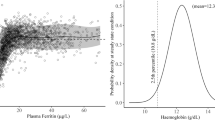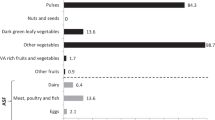Abstract
Objective: The objective of the study was to assess iron status in women of different physiological staus of two socio-economic groups in Bangladesh.
Design: Cross sectional study, using 3-day food record and blood haemoglobin, serum iron, serum ferritin concentrations.
Setting: Two regions of Bangladesh. The Dhaka city area and west region of Nandail, Mymensingh.
Subjects: Women aged 16–40 y. The low socio-economic group (group L, n=101) consisted of rural women with precarious income levels. The high socio-economic group (group H, n=90) consisted of women with high income and educational levels. The groups were composed of three sub-groups (non-pregnant non-lactating=1, pregnant = 2 and lactating = 3).
Results: There was no significant difference between the corresponding sub-groups of the two socio-economic groups in dietary intake of iron. In all sub-groups, the intake of iron was much higher than the RDA level and mainly based on non-haem iron. Blood haemoglobin (B-Hb) concentration (P=0.000), serum iron concentration (P=0.005) and serum ferritin (SF) concentration (P=0.000) were affected by socio-economic status. Physiological status (PS) influenced the B-Hb concentration (P=0.000). Prevalence of anaemia ranged from 63 to 70% in group L and 27 to 66% in group H, respectively. The prevalence of empty iron store (SF concentration<12 µg/l) ranged from 35 to 59% in group L and 15 to 32% in group H, respectively. The prevalence of anaemia and iron deficiency (70 and 35% for sub-group L2; 66 and 32% for sub-group H2, respectively) were similar in the pregnant subjects of the two groups.
Conclusions: Subclinical iron deficiency was common in women of low socio-economic status. The pregnant subjects in the two groups was similar as regards iron status.
Sponsorship: The study was supported by the Academy of Finland, University of Helsinki and NorFa, Norway.
European Journal of Clinical Nutrition (2001) 55, 598--604
This is a preview of subscription content, access via your institution
Access options
Subscribe to this journal
Receive 12 print issues and online access
$259.00 per year
only $21.58 per issue
Buy this article
- Purchase on Springer Link
- Instant access to full article PDF
Prices may be subject to local taxes which are calculated during checkout
Similar content being viewed by others
References
ACC/SCN (1991) Controlling iron deficiency ACC/SCN State-of-the Art series, Nutrition Policy Discussion Paper no. 9. Geneva: Administrative Committee on Coordination-Subcommittee on Nutrition.
ACC/SCN (1992) Second Report on the World Nutrition Situation, Vol I: Global and regional results Geneva: Administrative Committee on Coordination-Subcommittee on Nutrition.
Ahmed AU (1993) Patterns of food consumption and nutrition in rural Bangladesh. IFPRI.
Ahmed K & Hassan N (1983) Nutrition survey of rural Bangladesh 1981–1982. Institute of Nutrition and Food Science, University of Dhaka Bangladesh
Alexander D, Ball MJ & Mann J (1994) Nutrient intake and haematological status of vegetarians and age–sex matched omnivores Eur J. Clin. Nutr. 48 538–546
Ball MJ & Bartlett MA (1999) Dietary intake and iron status of Australian vegetarian women Am. J. Clin. Nutr. 70 353–358
Beaton GH (1974) Epidemiology of iron deficiency. In Iron in Biochemistry and Medicine, eds. A Jacobs & M Worwood pp 477–528 London: Academic Press.
Beaton GH, Corey PN & Steele C (1989) Conceptual and methodological issues regarding the epidemiology of iron deficiency and their implications for studies of the functional consequences of iron deficiency Am. J. Clin. Nutr. 50 575–588
Borch-Iohnsen B, Meltzer HM, Stenberg V & Reinskou T (1990) Iron status in a group of Norwegian menstruating women Eur. J. Clin. Nutr. 44 23–28
Cook JD, Baynes RD & Skikne B (1992) Iron deficiency and the measurement of iron status Nutr. Res. Rev. 5 189–202
DeMaeyer EM, Dallman P, Gurney JM, Hallberg L, Sood SK & Srikantia SG (1989) Preventing and controlling iron deficiency anaemia through primary health care. A guide for health administrators and programme managers. Geneva: WHO.
Dillman E, Gale C, Green W, Johnson D, Mackler B & Finch CA (1980) Hypothermia in iron deficiency due to altered triiodothyronine metabolism Am. J. Phyiol. 239 R377–381
Edgerton VR, Gardner GW, Ohira Y et al (1979) Iron deficiency anemia and its effect on worker productivity and activity patterns Br. Med. J. 2 1546–1549
Elvira BC & Elba MS (1991) Iron status in non-pregnant women of child-bearing age living at greater Buenos Aires Eur. J. Clin. Nutr. 45 215–220
Expert Scientific Working Group (1985) Summary of a report on the assessment of the iron nutritional status of the United States Populataion Am. J. Clin. Nutr. 42 1318–1330
FAO/WHO (1988) Requirements for vitamin A, iron, folate and vitamin B 12 Report of a joint FAO/WHO expert consultation. Food and Nutrition Series 724. Geneva
Fogelholm M, Alopaeus K, Silvennoinen T & Teirila J (1993) Factors affecting iron status in non-pregnant women from South Finland Eur. J. Clin. Nutr. 47 567–574
Fricker J, Moel GL & Apfelbaum M (1990) Obesity and iron status in menstruating women Am. J. Clin. Nutr. 52 863–866
Gardner GW, Edgerton VR, Senewiratne B, Barnard RJ & Ohira Y (1977) Physical work capacity and metabolic stress in subjects with iron deficiency anaemia Am. J. Clin. Nutr. 30 910–917
Hallberg L (1995) Results of surveys to assess iron status in Europe Nutr. Rev. 53 314–322
Hercberg S, Galan P & Dupin H (1987) Iron deficiency in Africa. In Nutrition in the Gulf Countries Malnutrition and Minerals, ed. GH Brurne 201–236. World Review of Nutrition and Diet, Vol 54.Basel: Karger
Husaini MA, Karyadi D & Gunadi H (1983) Evaluation of nutritional anaemia intervention among anaemic female workers on a tea plantation. In Iron Deficiency and Work Performance, eds. L Halberg & N Scrimshaw 73–78. Washington, DC: The Nutrition Foundation.
Jahan K (1996) Nutrition survey of Bangladesh 1995–1996. A preliminary report. Institute of Nutrition and Food Science, University of Dhaka, Bangladesh.
Kim I, Yetley EA & Calvo MS (1993) Variations in iron-status measures during the menstrual cycle Am. J. Clin. Nutr. 58 705–709
Looker AC, Dallman PR, Carroll MD, Gunter EW & Johnson CL (1997) Prevalence of iron deficiency in the United states J.A.M.A. 277 973–976
Monsen ER (1988) Iron nutrition and absorption: dietary factors which impact iron bioavailability J. Am. Diet Assoc. 88 786–790
Munro BH (1993) Selected nonparametric techniques. In Statistical Methods for Health Care Research, eds. BH Munru & EB Page 81–98. Philadelphia, PA: Lippincott.
Outila T, Ka¨rkka¨inen M, Seppa¨nen R & Lamberg-Allardt C (1998) Food and nutrient intake of premenopausal female vegetarians and omnivores in Finland Scand. J. Nutr. 42 98–103
Pollitt E (1990) Malnutrition and infection in the classroom. Paris: UNESCO.
Reddy S & Sanders TAB (1990) Hematological studies on pre-menopausal Indian and Caucasian vegetarians compared with Caucasian omnivores Br. J. Nutr. 64 331–338
Scholz BD, Gross R, Schultink W & Sastroamidjojo S (1997) Anaemia is associated with reduced productivity of women workers even in less-physically-strenuous tasks Br. J. Nutr. 77 47–57
Skikne BS (1988) Current concepts in iron deficiency anemia Food. Rev. Int. 4 137–173
Stata Statistical Software (1997) Release 5.0. College Station TX: Stata Press.
Strain JJ, Robson PJ, Livingstone MBE, Primorse ED, Savage JM, Cran GW & Boreham CAG (1994) Estimates of food and macronutrient intake in a random sample of North Ireland adolescents Br. J. Nutr. 72 343–352
Takkunen H (1976) Iron deficiency in the Finnish adult population. An epidemiological survey from 1967 to 1972 inclusive Scand. J. Haematol. 25(Suppl) 1–91
Wolgemuth JC, Latham MC, Chesher A, Hall A & Crompton DWT (1982) Worker productivity and the nutritional status of Kenyan road construction laborers Am. J. Clin. Nutr. 36 68–78
Worthington-Robert BS, Breskin MW & Monsen ER (1988) Iron status of premenopausal women in a university community and its relationship to habitual dietary sources of protein Am. J. Clin. Nutr. 47 275–279
Yip R & Dallman PR (1988) The roles of inflammation and iron deficiency as causes of anaemia Am. J. Clin. Nutr. 48 1295–1300
Acknowledgements
The authors wish to thank Abu Ahmed Shamim, Nazrul Islam and Marika Hollmen for technical assistance. The authors sincerely wish to thank 191 volunteer subjects of Bangladesh who provided blood samples, all kinds of information required for this study and made this study possible. The authors are highly grateful to field workers and nurses who helped to motivate the subjects to parcipate in this study. The study was funded by the Academy of Finland and the University of Helsinki.
Author information
Authors and Affiliations
Corresponding author
Rights and permissions
About this article
Cite this article
Islam, M., Lamberg-Allardt, C., Bhuyan, M. et al. Iron status of premenopausal women in two regions of Bangladesh: prevalence of deficiency in high and low socio-economic groups. Eur J Clin Nutr 55, 598–604 (2001). https://doi.org/10.1038/sj.ejcn.1601190
Received:
Revised:
Accepted:
Published:
Issue Date:
DOI: https://doi.org/10.1038/sj.ejcn.1601190
Keywords
This article is cited by
-
Anemia among Muslim Bedouin and Jewish women of childbearing age in Southern Israel
Annals of Hematology (2015)
-
Prevalence of iron deficiency among schoolchildren of different socio-economic status in urban Turkey
European Journal of Clinical Nutrition (2005)
-
Dietary calcium intake in premenopausal Bangladeshi women: do socio-economic or physiological factors play a role?
European Journal of Clinical Nutrition (2003)



